FizziCalc
Intermediate
Advanced
Cool Topics
Reference
Search
Games and Fun Stuff
Meeting Forum
Physics Links
Magnetism |
|
Return to the Intermediate Level Page.
 Magnets exert magnetic forces on each other and on certain materials, such as iron, that are called ferromagnetic materials.
All magnets have two poles, a north pole and a south poles.
Like electric charges, opposite poles attract while same poles repel each other.
Also similar to electric charges, magnetic field lines originate from the north pole and go to the south pole.
The illustration to the right shows the field lines around a bar magnet (click on the illustration for a VRML model of the field lines).
As you can see, the field lines go from one pole to the other.
Magnets exert magnetic forces on each other and on certain materials, such as iron, that are called ferromagnetic materials.
All magnets have two poles, a north pole and a south poles.
Like electric charges, opposite poles attract while same poles repel each other.
Also similar to electric charges, magnetic field lines originate from the north pole and go to the south pole.
The illustration to the right shows the field lines around a bar magnet (click on the illustration for a VRML model of the field lines).
As you can see, the field lines go from one pole to the other.It turns out that magnetic force arises from moving electric charges. If you place a compass (which has a magnetic needle) near a wire and then put current through that wire, the compass needle will align itself perpendicular to the wire. The magnetism in a magnet is due to the motion of electrons in the atoms of the magnet.
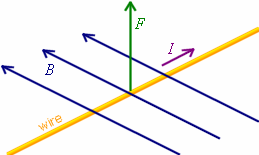 Magnetic fields exert a force on any charge in motion.
For example if you had a wire with a positive current moving to the right and you had a magnetic field (B field) directed perpendicular to it as shown in the illustration to the left, a force would move the wire upward.
Magnetic fields exert a force on any charge in motion.
For example if you had a wire with a positive current moving to the right and you had a magnetic field (B field) directed perpendicular to it as shown in the illustration to the left, a force would move the wire upward.This is your first right hand rule. To find the direction of the force, take your right hand and point your thumb toward the direction of current. Then take your four other fingers and point them in the direction of the B field. The force should come up out of your palm. If you are working with a negative current flow, then you would switch the direction of the positive current flow and use your left hand to find the force.
Like an electric field, magnetic field strength can be measured by the concentration of the lines of force in a specific region. These lines of force can also be called magnetic flux lines. The unit for measuring the number of flux lines is the weber (Wb). Flux density is the number of flux lines in a given area, and is measured with a unit called the tesla (T), which equals one Wb/m2. The B field strength is similar to the E field strength in an electric field.
Magnetic Field Interaction
Just like electric charges, magnetic fields of poles also interact to cause poles to repel or attract.Same Poles (click on the illustration for a VRML model):
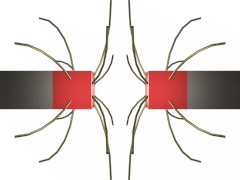
Opposite Poles (click on the illustration for a VRML model):
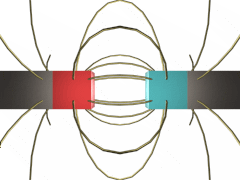
You can see how similar they are to the electric fields of point charges in the illustrations above.
Fields Around Currents
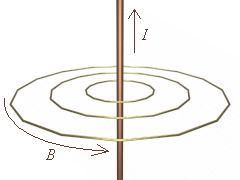 When current flows through a wire, a magnetic field is set up because of the moving charges.
For a straight conductor, the magnetic field always circles around the cross-section of the wire, as shown in the illustration to the right (click on the illustration for a VRML model of the field lines).
The direction of the B field can be found using the second right hand rule.
When current flows through a wire, a magnetic field is set up because of the moving charges.
For a straight conductor, the magnetic field always circles around the cross-section of the wire, as shown in the illustration to the right (click on the illustration for a VRML model of the field lines).
The direction of the B field can be found using the second right hand rule.Use your right hand and point your thumb in the direction of the positive current flow. Next, take your four other fingers and curl them around. The circle that those fingers make is the direction of the B field around the wire. Again, if you are dealing with negative current flow, use your left hand and point your thumb in the direction of negative current flow. If you put a compass nearby the wire, the compass needle will align itself with the direction of the B field.
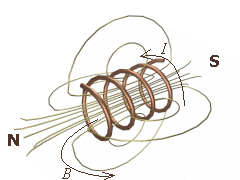 A solenoid is a wire that has been coiled up.
The magnetic field of a solenoid resembles that of a bar magnet as seen on the illustration to the left (click on the illustration for a VRML model of the field lines).
The lines of flux come out of the north pole at one end and curve around back to the south pole.
If you place a piece of iron or another ferromagnetic material inside the coil, it will become an electromagnet.
Also, the strength of the field increases as the number of coils increase.
The third right hand rule can be used to determine which direction is the north pole.
A solenoid is a wire that has been coiled up.
The magnetic field of a solenoid resembles that of a bar magnet as seen on the illustration to the left (click on the illustration for a VRML model of the field lines).
The lines of flux come out of the north pole at one end and curve around back to the south pole.
If you place a piece of iron or another ferromagnetic material inside the coil, it will become an electromagnet.
Also, the strength of the field increases as the number of coils increase.
The third right hand rule can be used to determine which direction is the north pole.Using your right hand, take your four fingers and curl them around in the direction of positive charge current around the coils. Stick your thumb out and that should be the direction of the B field inside the solenoid and also the direction of the north pole. Again, for a negative current flow, use your left hand.
Electromagnetic Induction
If a wire is moved through a magnetic field so that it cuts across magnetic flux lines, the charges in the conductor will be acted upon by the magnetic force. This force will move the charges towards one side of the wire. Because of this, a potential difference between the ends of the conductor will occur. This potential difference is induced by the magnetic field.In many power plants, huge rotating magnets make wires cut across their flux lines, generating the electricity that you get at home.